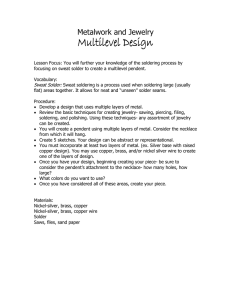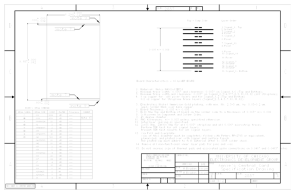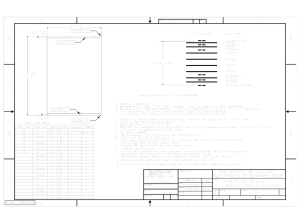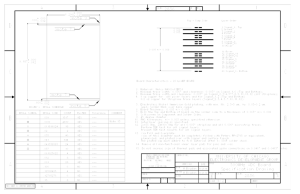solder joint design
advertisement
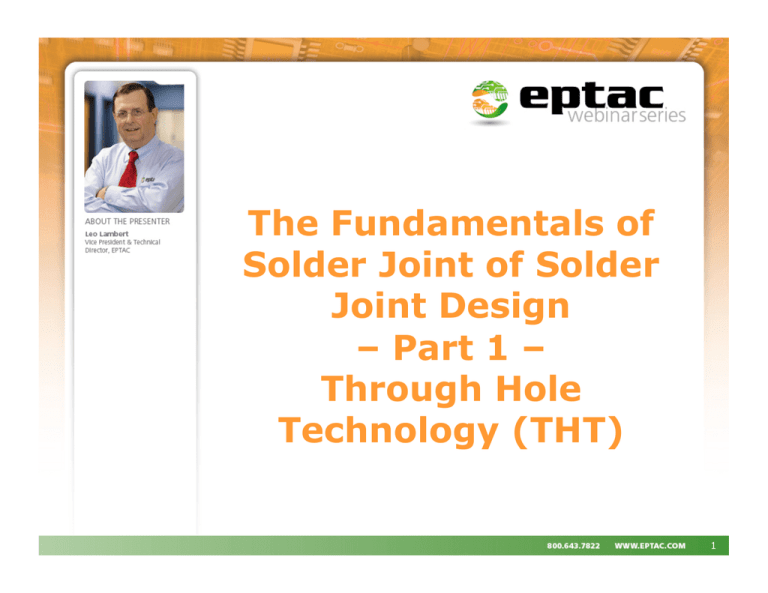
The Fundamentals of Solder Joint of Solder Joint Design – Part 1 – Through Hole Technology (THT) 1 SOLDER JOINT CRITERIA Designed for: • Electrical conductivity • Mechanical stability • Heat dissipation 2 SOLDER JOINT CRITERIA Solder Joint Must Have • Ease of manufacturing • Simplicity of repair • Inspectable 3 SOLDER JOINT DESIGN Solder joint are typically designed around the weakest cross sectional area of the weakest member of the joint itself. 4 Design Evaluation • Know the weakest part of the solder joint • Know the environment the solder joint will be subjected to in its useful life • Understand the metallurgy of cooling solder • Check stress distribution of the solder joint and the part being soldered. 5 Overview of Soldering What does it take to make a solder joint: • • • • • • Properly prepared materials Properly designed materials Fluxes Solder Heat Metallurgical bond 6 Wetting Angles 7 Equilibrium of Wetting γ SV = γ LS + γ LV Cos θ γ LV Liquid Solder Vapor θ γ SV Solid γ LS θ = Dihedral Angle γ = Forces of the surface energies γSV = Solid Vapor interface γLS = Liquid Solid interface γLV = Liquid Vapor interface 8 Liquid Forces Liquids have two forces: • Cohesive • Adhesive 9 Cohesive Liquid Forces Will tend to make the solder ball up on the surfaces Can create either a: • Non-Wet condition or • De-wet condition 10 Adhesive Liquid Forces • Adhesive forces will allow the solder to wet the solid base metal. • Will create the capillary action up into plated through holes • Will allow the solder to spread over the surfaces being soldered 11 Plated Through Hole Pads The design is a compromise: • Board density and minimum electrical spacing require small pads • Joint strength and reliability require as large a pad as possible 12 Plated Through Hole Solder Joint Adapted from Soldering Handbook for Printed Circuits and Surface Mounting, by Howard H. Manko, Van Nostrand Reinhold 13 Parameters 0.02 Land/line width 0.032 0.04 8.04E-04 D w = WIRE DIAMETER Dh = HOLE DIAMETER AC = π *(Dw/2)2 0.12 8.25 OUTSIDE DIAMETER OF LAND µ = RESISTIVITY RATIO 7.5 0.04 2 OZ COPPER WIRE CONDUCTIVITY Lj = lap joint length = π/4µD 5.85 The strength ratio of OFHC/SN63 is β 31 Tensile strength of 20 AWG wire in pounds 9.8 20 GAUGE WIRE CAN CONDUCT 9.8 AMPS AT 122F 7.5 Conductivity of 2 oz copper with a land width or 0.020, in amps 10 Peel strength 1 square inch of 1 oz copper in pounds 14 Peel strength 1 square inch of 2 oz copper in pounds 0.778 f function of hole clearance from table 1-4 0.0625 Tb = thickness of the board 0.02 0.005 HC = height for 2 oz copper layer H1 = SIDE 1 FILLET 0.02 H2 = height for single sided board bottom side 6.28E-02 Lcc=π/2*Dh Adapted from Soldering Handbook for Printed Circuits and Surface Mounting, by Howard H. Manko, Van Nostrand Reinhold 14 Mechanical Strength Zone 1 Lead clinched onto pth pad Lj = π/4 β D X= Zone 2 PTH pad opposite of clinched lead Zone 3 Plated Through Hole 3.68 X = (p/4) * ((b (DW/Lj)) Zone 5 Straight Through Lead, Single sided board Zone 4 Top side pth As = π * Dh* f* As =π * Dh* f* 4.89E-04 1.96E-03 H1 H2 As =π*DW*Tb 6.28E-03 X*As = β * Ac 0.75 X*As = β *Ac 9.62 X * As = β * Ac 2.41 1/X = 133.5% 1/X = 10.4% 1/X = 41.6% Critical copper area, Lcc=π/2*Dh 1/X = 27.2% Lbs 8.43 8.43 41.40 3.22 12.88 Comparison to tensile strength of AWG 20 Gage wire at 31 pounds 27.2% 27.2% 133.5% 10.4% 41.6% Comparison to peel strength of 1 oz copper foil at 10 lbs/in2 84.3% 84.3% 414.0% 32.2% 128.8% From table the tensile strength of copper AWG 20 gauge is 31 pounds Zone can support Adapted from Soldering Handbook for Printed Circuits and Surface Mounting, by Howard H. Manko, Van Nostrand Reinhold 15 Solder Joint Zone I & II Mechanical Strength Zone 1 Lead clinched onto pth pad Zone 2 PTH pad opposite of clinched lead Lj = (π/4) β D X= 3.68 1/X = 27.2% Lbs 8.43 8.43 Comparison to tensile strength of AWG 20 Gage wire at 31 pounds 27.2% 27.2% Comparison to peel strength of 1 oz copper foil at 10 lbs/ in2 84.3% 84.3% X = (p/4) * ((b (DW/Lj)) Critical copper area, Lcc=π/ 2*Dh From table the tensile strength of copper AWG 20 gauge is 31 pounds Zone I & II can support Adapted from Soldering Handbook for Printed Circuits and Surface Mounting, by Howard H. Manko, Van Nostrand Reinhold 16 Solder Joint Zone III Zone 3 Plated Through Hole As =π*DW*Tb 6.28E-03 X*As = β * Ac 0.75 1/X = 133.5% From table the tensile strength of copper AWG 20 gauge is 31 pounds Zone 3 can support 41.40 Comparison to tensile strength of AWG 20 Gage wire at 31 pounds 133.5% Comparison to peel strength of 1 oz copper foil at 10 lbs/ in2 414.0% Adapted from Soldering Handbook for Printed Circuits and Surface Mounting, by Howard H. Manko, Van Nostrand Reinhold 17 Solder Joint Zone IV Zone 4 Top side pth As = π * Dh* f* H1 4.89E-04 X*As = β *Ac 9.62 1/X = 10.4% From table the tensile strength of copper AWG 20 gauge is 31 pounds Zone 4 can support 3.22 Comparison to tensile strength of AWG 20 Gage wire at 31 pounds 10.4% Comparison to peel strength of 1 oz copper foil at 10 lbs/in2 32.2% Adapted from Soldering Handbook for Printed Circuits and Surface Mounting, by Howard H. Manko, Van Nostrand Reinhold 18 Solder Joint Zone V Zone 5 Straight Through Lead, Single sided board As =π * Dh* f* H2 1.96E-03 X * As = β * Ac 2.41 1/X = 41.6% From table the tensile strength of copper AWG 20 gauge is 31 pounds Zone 5 can support 12.88 Comparison to tensile strength of AWG 20 Gage wire at 31 pounds 41.6% Comparison to peel strength of 1 oz copper foil at 10 lbs/in2 128.8% Adapted from Soldering Handbook for Printed Circuits and Surface Mounting, by Howard H. Manko, Van Nostrand Reinhold 19 Comparison of Zones Tensile strength of solder joint, psi Joint strength compare to wire strength, 20 AWG = 31# Joint strength compared to peel strength of the 1 oz. foil, 1oz = 10psi on FR-4 Zone I 8.43 27.2% 84.3% Zone II 8.43 27.2% 84.3% Zone III 41.4 133.5% 414% Zone IV 3.22 10.4% 32.2% Zone V 12.8 41.6% 128.8% Adapted from Soldering Handbook for Printed Circuits and Surface Mounting, by Howard H. Manko, Van Nostrand Reinhold 20 Thank You Questions? 21 21 Further Information Our Next session will discuss the design and strength of Surface Mount Leads For questions regarding this webinar, please contact Leo Lambert at leo@eptac.com or call at 800-643-7822 ext 215 For information on any of EPTAC’s or IPC’s Certification Courses, please visit our website at http://www.eptac.com 22
